The 10 best places to resell your old clothes online
Finally, list that sweater that’s been sitting in your closet.
Products are chosen independently by our editors. Purchases made through our links may earn us a commission.
Cleaning out your closet can be extremely therapeutic; it’s easy to say goodbye if something doesn’t fit, you don’t wear it anymore, or it’s not even comfortable. The chaos comes in when you’re looking at a massive pile of clothes and have no idea what to do with them. When you’ve got perfectly good clothes, just giving them away can feel like a waste, but selling them can feel so overwhelming. As a reselling connoisseur who’s made over five figures doing so, I am here to tell you that it doesn’t have to be stressful. There are a ton of sites that make it easy to sell your old stuff for a profit—you just need to sell with a strategy.
Sure, you’ll have to take some pictures and spend some time posting them, but you can make some serious cash while cleaning out your closet—at the time of this writing, I’ve sold eight items in the past week. Different apps have different “cultures,” seller’s fees, and specific things you need to know to convert clothes into cash.
As an online seller for over six years, here’s a breakdown of the 10 most popular resale sites, how to list items, and how to actually make money from them.
1. Poshmark
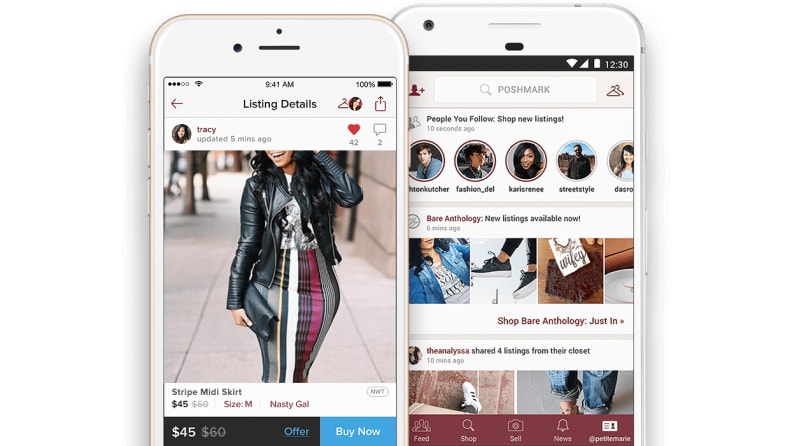
This is a go-to for selling clothing.
What it’s good for: If you want to play a more active role in selling your clothes (read: more money faster!) Categories: Men’s, women’s, and children’s clothing, shoes, and accessories Its cut: On sales under $15, it takes a flat $2.95 fee; on sales above $15, it takes a 20% cut Shipping: Printable label paid for by the buyer
Some people will tell you that Poshmark is a “lot of work” but in my experience, that’s an exaggeration. Unlike any other app on this list, Poshmark allows you to play an active role in promoting your listings for free as much as you want, thus getting your item in front of sellers instead of just waiting for them to stumble upon you. It does require more work than just posting, but the results show way more sales, as one of our writers has made over $1,700 on Poshmark.
Poshmark hosts something called “parties,” a two-hour window that’s theme- or brand-specific, and if your item matches the party’s theme, promoting it is as easy as retweeting, posting to Facebook, or hitting a button. For instance, if there’s a “Best in Bags” party, and you’re selling an old purse, you can just hit the “share listing” button and anyone looking at bags at that time will see your listing. You can also reshare your listings to your followers at any time of day, which gives you a little more agency in getting your items out there. Additionally, you can also “promote your items to likers” by offering a discounted price and shipping to anyone who liked your item. If you’ve got a ton of likes, but no sales, this is a great way to nudge anyone who was interested enough to like the item.
Once someone buys one of your listings, you do need to mail it directly to them. Poshmark uses priority mail labels for shipping, so when you go to the post office, you can package it up in a priority mail envelope for free since the mailer bag is covered by the cost of the label.
Pro Tip: I’ll look at a profile of someone selling similar items to mine and reshare about 10 of their listings to my followers, and oftentimes the owner of that profile will return the favor. It’s an easy way for promotion and helps other sellers out.
2. Tradesy
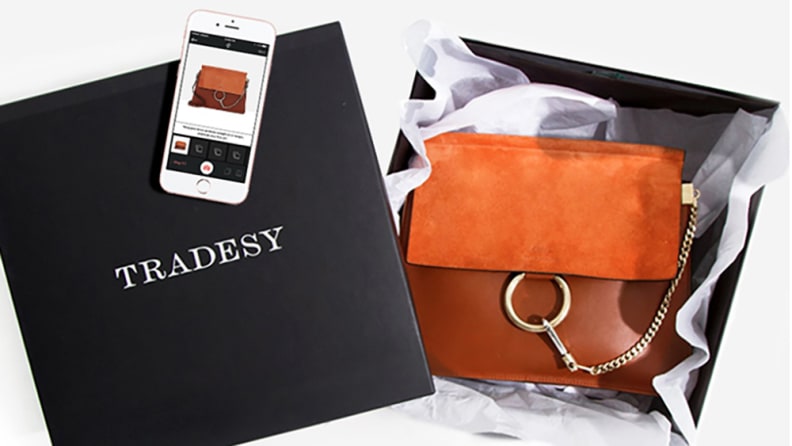
This site is best for higher-priced goods.
What it’s good for: Selling designer and high-priced items Categories: Women’s clothing, shoes, accessories, and wedding goods (dresses, decorations, invitations, bridesmaid dresses, etc.) Its cut: On sales under $50, it takes a flat fee of $7.50; on sales above $50, it takes a 19.8% cut Shipping: Tradesy can send you a plastic mailer for $16.80, which is paid for by the buyer; Tradesy can send you a premium box for $37.50, which is paid for by the buyer; you can print a prepaid label and package the item in your own mailer; or set your own mailing price to be paid for by the buyer
For those items that you know are worth more than $40, Tradesy might be a great option for you. People on Tradesy are selling Birkin bags for upwards of $35,000, so there’s a rather low likelihood that someone will nickel-and-dime for what you’re listing. It’s definitely a site for luxury items, but shoppers are in the market for these things, which makes it easier to move inventory.
Once you upload your photos, Tradesy will crop out any background images on the first photo on the listing, so make sure that the first picture you upload is very clear or you’ll get less interest for those perusing the platform. After purchasing an item, Tradesy gives buyers a five-day window once it’s delivered to inspect the goods, which means you’ll get paid a little later using this service. That said, I’d recommend printing the pre-paid label or setting your own postage price rather than using the Tradesy branded packaging, which you need to wait to ship to you before shipping off your goods, further delaying your payout.
3. ThredUp
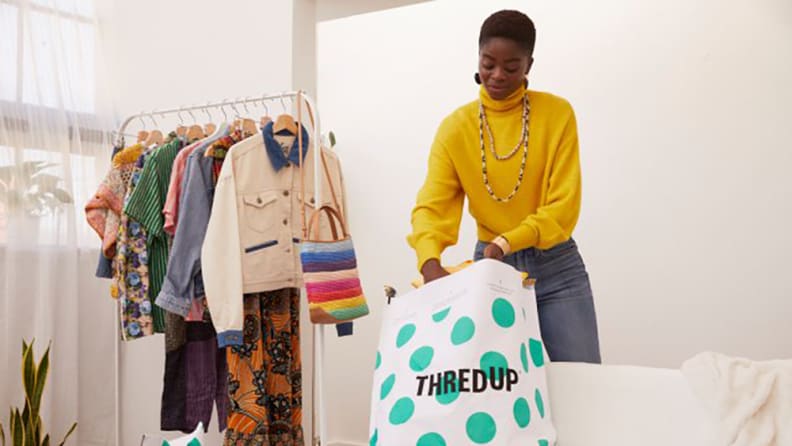
For when you just want to get rid of your clothes.
What it’s good for: If you want to do minimal work and get the clothes out of your house Categories: Women’s and children’s clothing and shoes Its cut: It will take 5 to 95% of the listed price, depending on the product Shipping: Free mailer
The selling fees on ThredUp may seem a little jarring, but they’re that high because the site is like an online consignment shop. ThredUp literally does all of the work for you, from taking photos to listing items to mailing. It’s one of the best options if you’re looking for the least amount of effort. The site offers a Clean Out Kit for sellers, which I absolutely love for getting rid of a bulk amount clothes.
Here’s how it works. First, decide if you want to sell the clothes you send in or donate them instead in exchange for a $5 ThredUp credit. If you decide to sell, you can either send in the clothes yourself with a prepaid label or get a free mailer bag with a prepaid shipping label sent to you that you fill with clothes and send back to ThredUp (I always choose the bag because it’s massive). It’s that easy.
But like most consignment shops, ThredUp only accepts about 40% of the items it receives. You can either have ThredUp send back its rejections to you for $10.99 for return shipping or have the clothes recycled. The average processing time for sending in clothes to ThredUp is eight weeks, but you can also opt to spend an extra $16 for expedited processing that bumps it down to three weeks.
I’ve made about $80 off three big bags of old shorts and cotton tees, and let ThredUp recycle whatever it couldn’t sell. While I didn’t strike gold on these sale-wise, I just wanted these items out of my closet, so I mailed the bags, completely forgot about it, and woke up one day $80 richer.
4. eBay
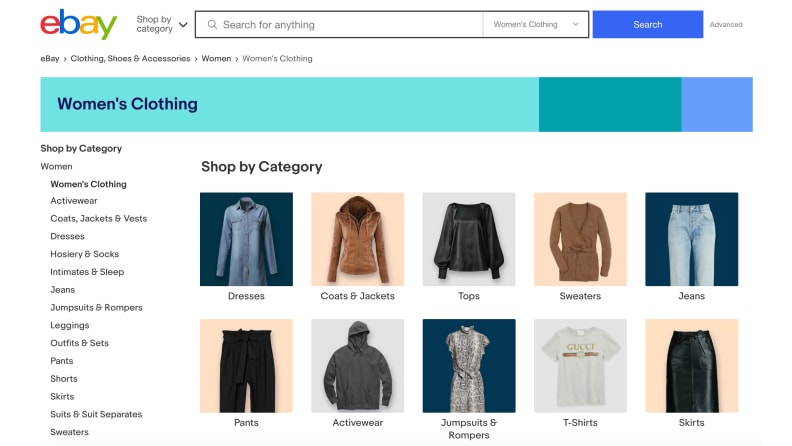
A screenshot of the women's clothing page on eBay.
What it’s good for: Selling everything Categories: Every category from home, clothes, shoes, tech, and more Its cut: eBay keeps 12% of clothing sales Shipping: You can choose to charge the buyer or pay it yourself
Ebay is the OG online marketplace. While there are people on the site selling used Teslas, you can also sell that sweater your nana bought for you three years ago that still have the tags on it. Though eBay is an auction site, where people can place bids on your listings, I’m not a huge fan of the auction feature when it comes to selling clothing. I rely heavily on the “buy it now” function because you’re more likely to get your desired asking price. For example, with the auction feature, if the highest bid is $16 and you were hoping for $40, you’re stuck with $16. While you can set a minimum price for the auction, eBay will reject all bids under that number.
To be honest, it feels more complicated than it’s worth, so I just set all of my listings as “buy it now” with my desired price. Sometimes there are also additional fees for listing items as an auction item and I’m in the business of maximizing my earnings, so I avoid auctions altogether. There are other ways to sell on the platform that may work better for you, so it might take a few listings to get in your groove. I will say that with 182 million worldwide users, you’re bound to find someone somewhere that wants to buy your stuff.
5. Depop
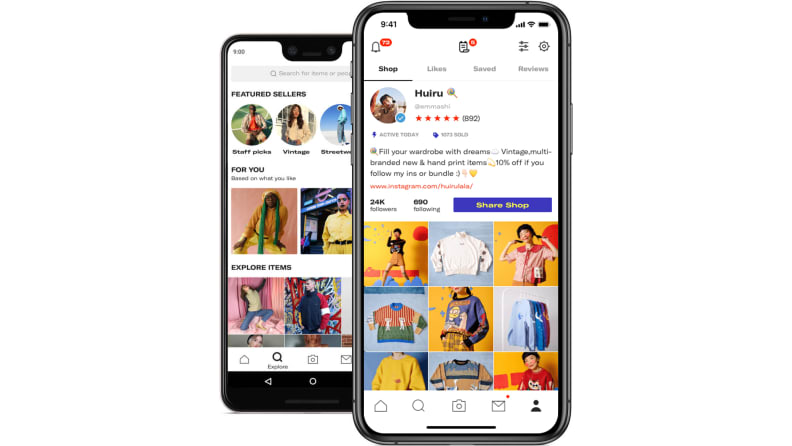
Gen Z really loves this vintage Y2K clothing.
What it’s good for: Anything, but especially clothing you’re trying to sell for less than $30 Categories: Men’s and women’s clothing, home goods, tech, movies, sports equipment, books, beauty, and transportation Its cut: Depop keeps 10% of the sale price of any item Shipping: You can pay for shipping or charge the cost to the buyer
I have the least experience with Depop, but I know that the kids (a.k.a. Gen Z) love it. This is important to note because as an older person (by their standard), some of the graphic tees I have from high school 15 years ago are now considered both “vintage” and cool. I watched a teenager in a YouTube video explaining that an XL Harley Davidson tee would fetch about $30 because it was vintage, even though the shirt seemed to be from the 2010s. You’ll also find many influencers selling their stuff on here, so it’s helpful to have a loyal fanbase while posting.
Keeping with the Gen Z theme, you can use hashtags to help people easily find your items. For example, a “vintage yellow Harley Davidson tee” could be easily found using #HarleyDavidson #SizeXL #VintageTee #Yellow #MuscleTee #HarleyDavidsonTee #1990s. I’m sure you #GetIt by now. While adding hashtags to your listings may be a challenge at first, the effort is definitely worth the payout.
6. OfferUp

This app can be helpful for selling locally, but is filled with scammers.
What it’s good for: Selling locally Categories: Men’s, women’s, children’s, and baby’s clothing, shoes, cars, games, art, pet supplies, wedding, beauty, business equipment, and tickets Its cut: Offer Up takes 12.9% of the sale Shipping: Prepaid labels paid for by OfferUp
OfferUp, which recently acquired the similar selling app LetGo, is designed for in-person transactions—meaning the people in your area. I prefer to cast a wider net across the country, so I opt to make all of my listings eligible for shipping. That said. I’ve been on the app for a few months and have sold nothing.
My biggest warning with using OfferUp is to be wary if someone asks you, “Hi is this still available.” It sounds like a silly thing to look out for, but within minutes of opening my account and listing my first three items, I received four of these messages, which I found to be suspicious because of course it’s available, I just listed it! But I responded to these messages and each person asked for my phone number to confirm that I was a real person. I Googled to see if I was overreacting and immediately found several pages that warned that this was a common OfferUp scam. This scheme can be found by sellers who have new profiles and are offering to pay with no negotiating. To avoid this, users recommend only selling locally on the app, where you can meet and get your cash IRL.
My account is still open, though, because I list most of my items on multiple sites anyway, but I think you’re better off using Facebook Marketplace, where you can vet buyers more easily, though you’ll have to sell locally, too.
7. The RealReal
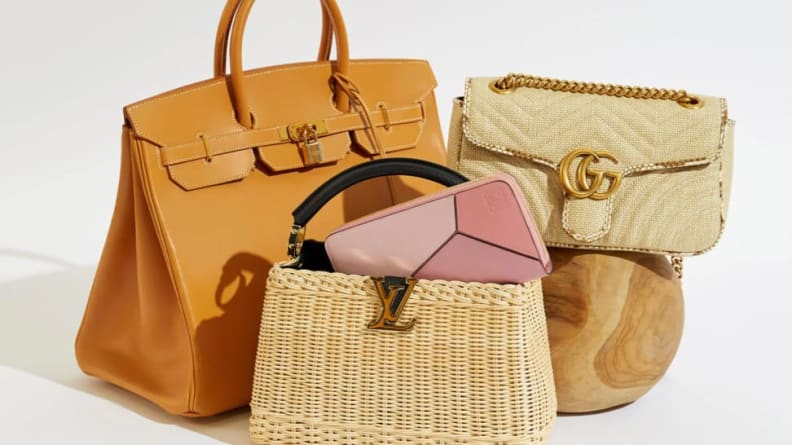
Designer products at low prices.
What it’s good for: Some designer goods Categories: Men’s, women’s, and children’s clothing, shoes, and accessories Its cut: The Real Real takes 30-50% of the sale Shipping: You mail the item to The RealReal, and it will mail it to the buyer
The RealReal is like if Tradesy and ThredUp had an online consignment shop baby. It’s great for high-end items and the site does all of the work (taking high-quality photos, listing the item, setting the price, and shipping it). There are also a few brick-and-mortar stores, and if you live nearby, you can make an appointment to bring your items in and get an appraisal. Before the pandemic, if you were a high roller and wanted to truly clean out your closet, The RealReal offered a home visit service and had experts to go through anything you wanted to sell.
As a New Yorker, I’ve gone into a local shop to see if my items were eligible. I was once frustratingly turned away because they didn't take a brand that they had previously accepted the season before. Since The RealReal does all the heavy lifting, it can discount items as it pleases, meaning you may get less of a cut. So be warned that your diamond bracelet might be discounted by 20% down the line to sell it.
8. Mercari
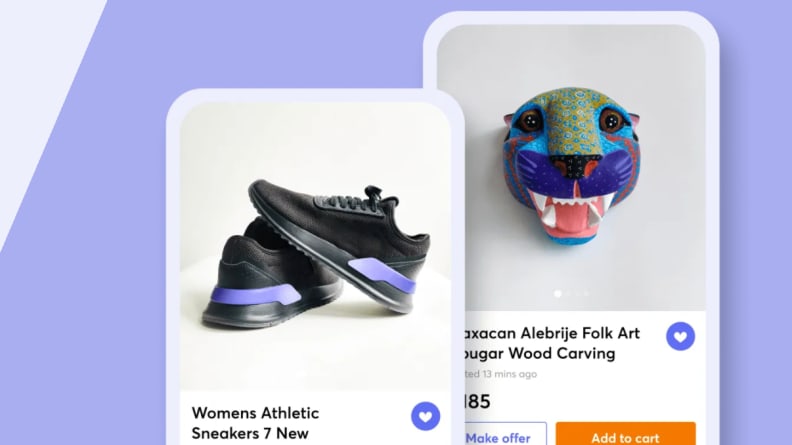
Y0u can sell everything here.
What it’s good for: Selling anything Categories: Men’s, women’s, and children’s clothing, shoes, toys, vintage items, handmade goods, and home goods Its cut: Mercari takes 10% of the sale Shipping: Prepaid labels
If you’re trying to maximize your profits, Mercari is a great option because it has one of the lowest selling fees of any of the platforms on this list. Similar to Depop, you can use hashtags to promote your items, but you can only use three so choose wisely. The chat function on Mercari makes it easy to communicate when it comes to bartering and going back and forth with a buyer.
If your item isn’t selling, you can “promote” it, which drops the price by 5%, notifies anyone who’s ever liked the item, and boosts your item up in the searches. Like Poshmark, you also have the option of offering a discounted price just to people who have liked your item. Once it sells, you have three days to ship it using prepaid labels, and once the buyer receives the item and rates their experience, you rate the buyer and get your money.
9. Facebook Marketplace

Sell your clothes locally with this social media app.
What it’s good for: Anyone with Facebook Categories: Men’s, women’s, and children’s clothing, shoes, accessories, women’s beauty, products, bags, and home furnishings Its cut: None if you’re selling as an individual; 5% if you’re selling as a merchant Shipping: You can choose to charge the buyer or pay yourself
Facebook Marketplace has been around since 2007. That’s right, while you were learning how to see what your ex was up to via their aunt’s profile, people were making money selling things on the same social media platform. The feature has increased in popularity in recent years, and you can sell your items to 1.79 million users, instead of just your immediate friends. Much like OfferUp, you can arrange meetups to exchange goods or choose to mail them by requesting the buyer pays for shipping.
To really be successful on this platform, you can join Facebook Groups to sell to people in your neighborhood or ones to sell items in a certain category. As long as you’re listing items as an individual, rather than a merchant that runs a shop, you won’t be charged any fees. So when you’re done stalking your ex, swing on over to the Marketplace tab and start selling those old clothes in your closet.
Sell clothes on Facebook Marketplace
10. Instagram Stories
What it’s good for: Anyone with Instagram Categories: Anything Its cut: None Shipping: You can choose to charge the buyer or pay yourself
I once tried to make an Instagram account solely devoted to the clothes I was selling and it was far too much work. But I’ve recently noticed some of my friends post clothing sales using the Instagram Stories feature, and it seems to be much more effective. First, they’ll post a story that has their terms and conditions along the lines of, “I want to sell my clothes. They’re first come first serve and flat shipping is $8. You can Venmo/Cash App/Paypal me and once I get a receipt, I’ll ship it.” Then they’ll post a single photo with the price of the items they want to sell. That’s it.
It’s so simple and brilliant because it’s an easy way to pawn off something to friends that commented on your last post that your “jacket is fire,” while not having to pay fees that come with traditional selling apps. It’s worked well for my influencer and non-influencer friends alike. So if you’ve got good taste, the ability to get to a Post Office, and some friends, this might work for you.
